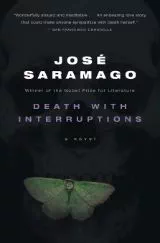Daisy Jones and The Six by...
Ever wonder what it would be like to be the l...
By Reanna Quitzon1580

0

“The following day no one died” With this incredible first line José Saramago opens his novel Death With Interruptions. In a nameless European country where these events take place, at the stroke of midnight on New Year’s Eve, and for no apparent reason, people stopped dying.
The new year came and with it came the realization of man’s lifelong dream of immortality. It seems like a blessing until reality hits and people realize that they continue to grow older, get sick, and get injured, without the relief of death to put an end to their suffering.
Immortality also strikes a powerful hit on the economy, driving businesses like funeral homes and life insurance to the edge of extinction. As we see how the government and the people handle this extraordinary situation, death!
“death,” with a small d, as she prefers it, offended by an article in some newspaper, sends a letter in a purple envelope, that is to become her signature, to the Prime Minister. In her letter, she notifies him that she is going to resume her business at midnight that day, but with a minor adjustment.
Death will send people one week’s notice letter in her purple envelope, so they could say their goodbyes and get their affairs in order.
This second change of circumstances relieves some people and horrifies others, but as things get to normal, or at least a new normal, the story starts to focus on death herself.
Intrigued by one notice letter that keeps returning to her, death starts her investigation into the man who should have received his death warning, a middle-aged cellist who lives alone with his dog. She starts observing him in his home, in his sleep, in his daily routine, all while invisible, but then grim reaper takes the form of a human lady and goes to listen to him play. Time after another, her courage fails her as she passes every opportunity to hand him his letter. death falls in love with a mortal.
Saramago is a Nobel Prize winner for a reason, he can take the most absurd hallucinations of fantasia and turn them into an emerging reality in his matter of fact style. It takes very little time for the reader to forget the impossibilities of the idea.
Death With Interruptions (Published in England as "Death At Intervals") has a strange writing structure. Saramago uses page-long paragraphs that never seem to end. There is scarcely a single period on each page, only commas.
Even in dialogues, not that many to begin with, there are no quotation marks. This could make reading this book a bit more difficult and maybe even discouraging. However, the brilliance of the ideas and the reflections of the narrator on society, human nature, and philosophical questions can certainly keep you motivated to power through the tough read.
Updated 4 years ago